Without a doubt this was a well-planned and executed tour, giving us just the right amount of culture, history, cuisine, and general knowledge about the Tokaj region and its storied history and culture of wine making.
The trip started out in Budapest: when we arrived at our quaint hotel in the castle district and we were ushered downstairs to a 400-year-old wine cellar where dinner and a wine tasting were already in progress. We had a traditional Hungarian meal with Goulash soup, Hortobagyi, Paprikas and a variety of other delicious house specialties. Each course was paired with a different Hungarian wine and we all got acquainted in person after knowing each other only by phone or Skype.
The next day we had a bus tour of Budapest with a guide giving us the history of not only the capital, but Hungary in general. We visited many of the city’s famous sites and even spent a couple of hours in the world-renowned outdoor baths. As this day was the Hungarian national holiday, there were many people in the city and several of the bridges were only accessible to pedestrians. Our hotel was near the castle, so we walked to the St.Matthias Church area where many Hungarian Kings were crowned and watched from a perch on the castle wall the celebratory fireworks shooting off over the Danube River by the Parliament building. It was a very impressive display with a beautiful backdrop of this magnificent structure. Early Tuesday morning we departed for the 3 hour bus trip to Tokaj to visit nine wineries: Béres, Grof Degenfeld, Erzsebet, Majoros, Serpens, Demetervin, Barta, Basilicus, and Holdvolgy. Upon arrival at our first destination, Béres Winery, we were greeted as we would be in most all the wineries: with the warmth of welcoming of an old friend in celebration of our visit with a sparkling or another refreshing Furmint wine. We toured most of the vineyards and learned about the terroir: the clay and volcanic soil & landscape, the position of the vineyards in relation to the Bodrog & Tisza rivers. We learned how the volcanic rocks keep the vineyards warm and the rivers provide the moisture and fog, encouraging the fungus to produce the desired sweet Szamorodni and Aszu wines. The 27 wine regions of Tokaj are diverse, from the microclimates, to the type of soil throughout their vineyards, and of course even the direction and incline of their hilly locations. The six grape types that can be officially sold as Tokaji wines allow for both pure varietals and blends. We learned the most about the top grape varietal, Furmint, and its importance to the fame, history and wine culture of Tokaj. We were pleasantly surprised by the 2nd grape varietal in Tokaj, Harslevelu. The wine made from this grape had a fruit bouquet and enhanced the Furmint-heavy blend by adding a slight sweetness and friendliness. While I could write significant detail on our visits to each of these beautiful wineries (and I may), the takeaway was clearly that the wines of Tokaj are elegant and pair exceedingly well with a variety of foods or can be enjoyed by themselves. Living in Florida, I quickly learned that Furmint or blends with Furmint pair well with seafood, shellfish, spicy Thai/Vietnamese, and even with most vegetables. When we traveled Tokaj our minds were opened after tasting these noble wines with traditional Hungarian fare, much of which is also readily available in America: pork, beef, chicken, duck, goose liver, peppers, and foods that have a mild spice. The tour combined just the right amount of culture, history of the people and country, geography, visits to important sites, with a deeper understanding of the long history and renewed wine making efforts since 1990 in Tokaj. We were favorably impressed with the combination of knowledge, commitment, and the delicate understanding of how to let the region’s mild climate with a unique terroir and grapes make wines. We are confident that these wines will be acclaimed as they were in the past throughout many countries, including America. Editor’s note: Select Tokaji Wines are now available at The Wine Merchant in Naples, Florida. For more information, please email Rick Perry at rperry@fbintllc.comThe Illinois Science and Technology Coalition (ISTC) is a 30-year old, member-driven nonprofit that measures, connects and advocates for the Illinois tech economy, and ISTI (the Illinois Science and Technology Institute) is their C3 arm, specifically focused on the STEM talent pipeline. Since being established in 2012, ISTI has developed programs to better connect companies with classrooms to help cultivate the next generation of innovators and problem-solvers.
Before beginning their programs, the ISTI team spent an entire year researching and talking to educators and industry members about gaps in talent development. They found that a disconnect exists between what students are learning in classrooms and what happens in the real world. A recent Randstad report cited by Mark Harris found that a large number of students didn’t even know anyone with a job in STEM. “When asked to think about STEM jobs, [students] often mentioned NASA, not companies like Coca-Cola or State Farm,” Harris said. ISTI’s main goal: demystifying STEM careers for young people and connecting companies with classrooms in order to create a more inclusive and diverse talent pipeline. From this goal, the STEM Challenge was born.
“We want to demystify STEM careers for young people.” – Mark Harris, President & CEO of ISTCISTI’s STEM Challenge is a year-long process that invites students to tackle complex, interdisciplinary, real-world problems identified by industry. This year, there are 26 high schools participating in the STEM Challenge and 17 participating companies, amongst which you’ll find big names like Microsoft, Lenovo, AbbVie, Caterpillar and more. Generally, participating companies take on 1-3 schools, but Microsoft is taking a record-breaking 5 this year. Companies are scouted in the summer and the challenge content is facilitated by ISTI and devised by employees in order to achieve an authentic industry problem.
The goal is to present the students with “real, messy problems” that companies are facing. Schools and companies work together to define their own timeline and begin the year with a kickoff event where mentors, identified by the company, introduce themselves and their industry to the students. ISTI hosts a professional development for all participating teachers and provides coaches, all former educators, who help the teachers implement the challenge into their curriculum. After the kickoff, mentors visit the classroom throughout the year and even host the students at their organization for a site visit. In April, one team from each high school is chosen to attend the annual student showcase and present in front of an audience of 400+ industry professionals and peers.
The high school students who participate in the STEM Challenge aren’t the only ones doing the innovating—ISTI developed the Mentor Matching Engine for the initiative. In between in person visits, the students and mentors use the tool weekly to stay connected, video conference, and to securely share files. The tool is an invite-only platform with embedded background checks to ensure student safety. The platform is also being used by nonprofits, school districts, and by a number of schools for independent research. Harris elaborated that the mentoring platform “allows for new ways of scaling—a way to reach even more schools and students.”Currently, half of participating schools are Chicago Public Schools (CPS), 40% are suburban Chicago schools, and 10% are from southern Illinois, but ISTI continues to expand statewide. In the 2017-18 academic school year, 50% of student participants were female and just under half were people of color, both populations traditionally underrepresented in STEM fields. ISTI continues to deliberately strive to reach under-served populations in STEM.
So, what are some key outcomes from the STEM Challenge? Each year, ISTI gives a post-challenge survey to students, teachers, and mentors. In the 2017-18 academic year, the survey found:To learn more about the STEM Challenge and ISTI, view this video and check out their website here. If you are interested in getting engaged, contact Sarah Perret-Goluboff at spg@istcoalition.org.
Since 2012, FB International has been working with George Walker, a seasoned food-industry consultant, who knows just how important the industry is—after all, it has been a part of his daily life for the past twenty years.
Last week we sat down with George to ask him some questions about the food industry.
Can you tell me a bit about your career path—what got you into the food industry to begin with?
I sort of fell into the food industry. Out of college, I worked for several small, family-owned businesses. Initially I was working for Westvaco Corporation, an international manufacturer of papers and packaging; I started as the shipping supervisor, later became the printing & die cutting supervisor before eventually being promoted to superintendent. I then was hired as the plant manager for a family-owned Teflon-coating business.
After about a year in that industry, I applied at Keebler to be the shift manager for the third shift. After three years, Keebler purchased Ace Baking and closed most of their locations, save for one in Chicago which I was tasked with “Keeblerizing.”After a year I went back to the original facility in the Pullman area. Then we decided to expand the Pullman facility and I was sent to our Grand Rapids plant to learn about the Ready Crust Piecrust business and equipment which was to move into the expanded Pullman plant. Kellogg’s then bought Keebler and I became the Manufacturing Services Manager, a role that later evolved into R&D/in-house training, and then into a more day-to-day operations role before finally becoming an internal consultant.
After I began consulting for FB International, in 2013 I was offered a job at Ferrara Candy where I stayed for five years. They’d been recently purchased by Ferrero Rocher, my work at the Bellwood facility involved a lot of change management.
What would you say are some of the most common hazards you’ve encountered in the food processing industry, in terms of safety or quality control? What are some steps people in the industry could take to reduce these risks or mitigate these issues?
In terms of safety, people really want to do the right thing, whether they have a justification for it or not…and usually they don’t. From an employee standpoint, the biggest hazard is unsafe acts. For this reason, I am a DuPont Stop trainer and a big believer of most behavior-based safety programs. From the plant/corporate perspective: if you walk in a plant and it looks like it’s running well, it generally is and it generally has a good safety record. Clean and organized plants are usually safe plants.
Do you think other industries could benefit from knowledge-sharing from the food industry?
I think behavior-based safety programs transcend industry. For example, with the DuPont Stop program you go out two times per day and make observations on how people are doing jobs. It teaches you how to approach people, how to correct them if need be, but also how to give positive reinforcement. It also guarantees that you yourself know how the job is supposed to be done.
In your experience, is there something the American food processing industry can learn from other countries? Or vice-versa?
I think there is definitely a lot to learn from other countries, depending where you are going—it really depends region-to-region. For example, in Tanzania most foodstuffs are purchased from the daily market because there is no way to package them or refrigerate them. Because of this, a lot of food from Tanzania is sent directly to Kenya because they’re more capable of packaging it. I think this is a lesson for making foodstuffs available in canning & manufacturing environments where they otherwise wouldn’t be available.
Whereas in Europe, it depends on the type of food. With cone manufacturing for example, there is just no such thing as centralized manufacturing—which is what we had with Keebler in the US.
In the US, one of the biggest issues is a lack of accountability towards lean manufacturing. To remedy this, I would suggest providing resources like SOP and KPI development for companies, especially for SMEs.

When George Walker isn’t consulting for the food industry, he can sometimes be found on safari in Tanzania.
If you’d like to get in contact with George Walker, I invite you to take a look at his LinkedIn page. Make sure to follow FB International on Twitter , LinkedIn, and Facebook to see more posts like this.
Sources:
https://www.statista.com/topics/1660/food-retail/
FB International LLC has been working with New Wines of Hungary, a consortium of wines from the Tokaj region of Hungary, to help them augment their presence in the American market. Our Florida-based partner, Rick Perry, has been organizing wine tasting events in the community. Click here to read about the Crawfish Boil where Rick showcased the wines in April of this year.
In recent years, American interest in wine has skyrocketed. According to the International Organisation of Vine and Wine, Americans consumed 4.2 billion bottles of wine in 2016–that’s 13% of global wine consumption! With the world’s largest wine market, it can be difficult for new players to find their place. So what makes these Hungarian wines such great contenders? In the words of Balasz Humayer, president of New Wines of Hungary, it is the “uniqueness, [the] reasonable price, and the high quality-to-value coefficient of Hungarian wines [that] could result in a significant competitive advantage in the saturated yet open-minded US market.”
Recently, Rick held a free wine tasting at the Rotary Youth Services event at the Promenade in Bonita Springs, Florida. More than 500 rotarians were in attendance. Being surrounded by water, it’s no surprise that seafood was on the menu for the day. Read on to hear about the feedback Rick received about the various Tokaji wines made available for tasting.
The SERPENS Tokaj Dry wine was a fan favorite as an easy-drinking, “friendly” wine.
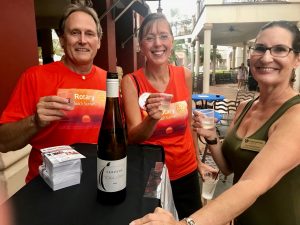
(L-R) Rick Perry, Debbie Perry, and Lisa Wilkinson of Diamond Oaks Village tasting the ever-popular SERPENS Tokaj Dry 2016.
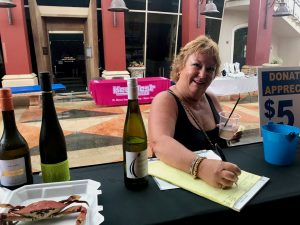
Event attendee Tressa Johnson requesting more information on where to find SERPENS in Southwest Florida.
The Hold and Hollo Dry Furmint blend was also a popular choice.
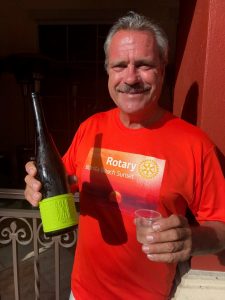
Rotarian Trace Taleck showcasing the Hold and Hollo Dry Furmint Blend. Taleck’s mother is of Hungarian descent and this was his favorite wine of the tasting.
The attendees found that the Majoros Tokaji Furmint Dry paired exceptionally well with the seafood, and Rick noted that “people appreciated it more when they did this.”
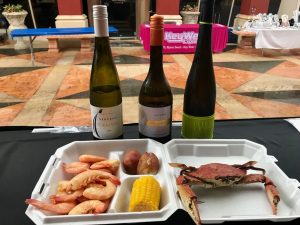
Florida blue crab & gulf shrimp boil with potatoes and corn paired with: SERPENS Tokaj Dry 2016, Majoros Tokaji Furmint Dry, and Hold and Hollo Furmint Blend.
There was also a request for the sweet Szamorodni, so Rick poured the Béres “to the delight of those who tried it.” Rick took note of some of the comments this dessert wine garnered: “Mmmh! Very nice.” “Pairs well with the shrimp!” “Where can I get this?”
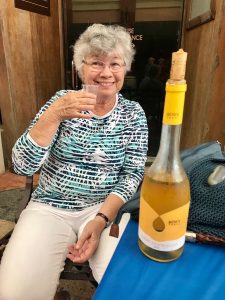
Mrs. DePalma, who requested a sweet wine, and was more-than-pleased to try Béres Sweet Szamorodni 2015.
The wine tasting paired extremely well with the seafood offering and helped to make the Rotary event a success. Like the attendees featured above, we are looking forward to seeing these Hungarian Tokaji wines in more stores and restaurants soon!
Sources:
International Organisation of Vine and Wine. (April 2017) Global State of Conditions Report: Developments and Trends. Retrieved from: http://www.oiv.int/public/medias/5251/en-communiqu-de-presse-2017-avri.pdfNew Wines of Hungary. About. Retrieved from: http://newwinesofhungary.com/
All photos courtesy of Rick Perry.During the week of June 18 – June 22, ten French and Spanish companies descended on the Windy City to learn more about the American market and to explore local business-to-business collaborations based on partnerships and trade. These companies are part of the RYME+ program, a European Union-funded consortium for the internationalization of innovative small and medium-sized businesses. The visiting delegates were spread across multiple sectors including, but not limited to: biotechnology, assistive technology, and manufacturing.
The visit kicked off on Monday, June 18th , with a day-long program at the Illinois Institute of Technology (IIT) University Technology Park hosted by IIT’s Associate Vice Provost, Catherine Vorwald, and organized by FB International LLC. Ms. Vorwald gave a warm welcoming speech and later gave the RYME+ participants a tour of the Tech Park and of some available offices and labs.
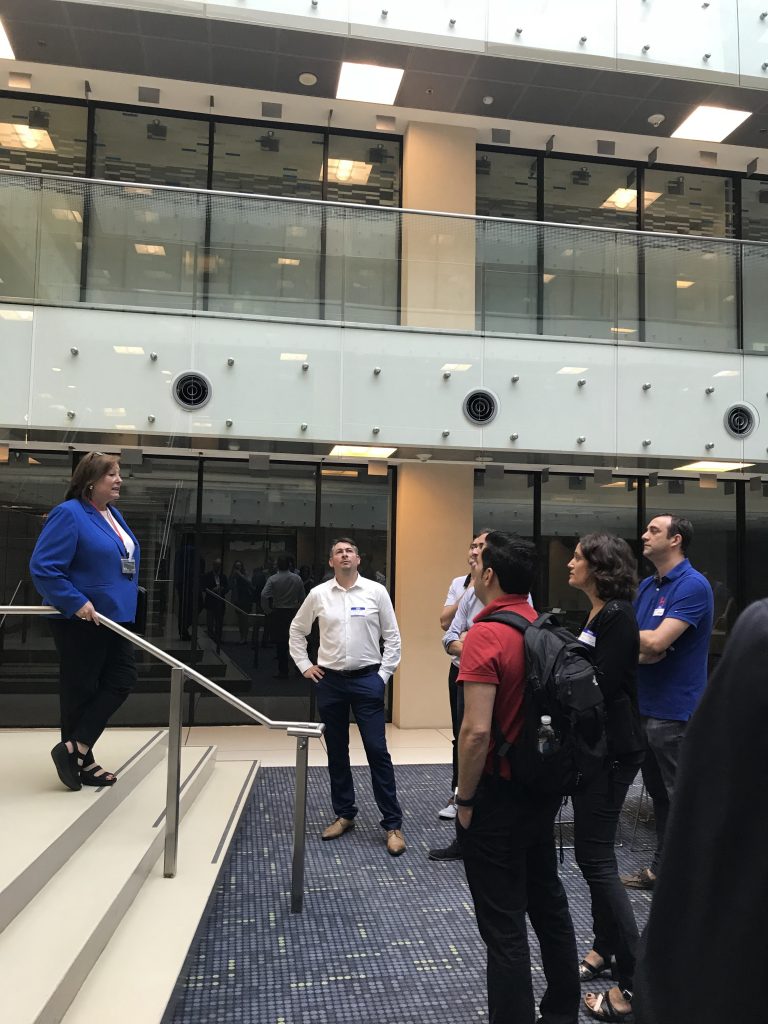
Catherine Vorwald (left) gives RYME+ Delegates a tour of IIT’s Tech Park, starting in the atrium as seen here
We had the pleasure of hearing presentations by Andrew Bond, Co-Founder & COO of DeNovX and David Dingott, CEO of Sword Diagnostics, who taught us about their pioneering companies and why they chose IIT’s University Technology Park (and Chicago) as their home. The ten RYME+ companies also practiced their elevator pitches for Mr. Bond, Mr. Dingott, and Ms. Vorwald who gave feedback and served as an American focus group before the companies’ numerous B2B meetings later that week.
To start the afternoon session at IIT’s Tech Park, FB International LLC’s president, Fabrice Bonvoisin, presented our Welcome Package along with the package’s partners: Jennifer Watson, Principal Attorney at Masuda Funai, and Thomas Beube, SVP and Director of International Services at Wintrust Financial Corporations. The Welcome Package is an efficient collaboration between Legal, Accounting, Banking, and Business Development which allows companies to establish a presence in the US by saving on administrative costs and adroitly spend their limited budget on sales and business development.
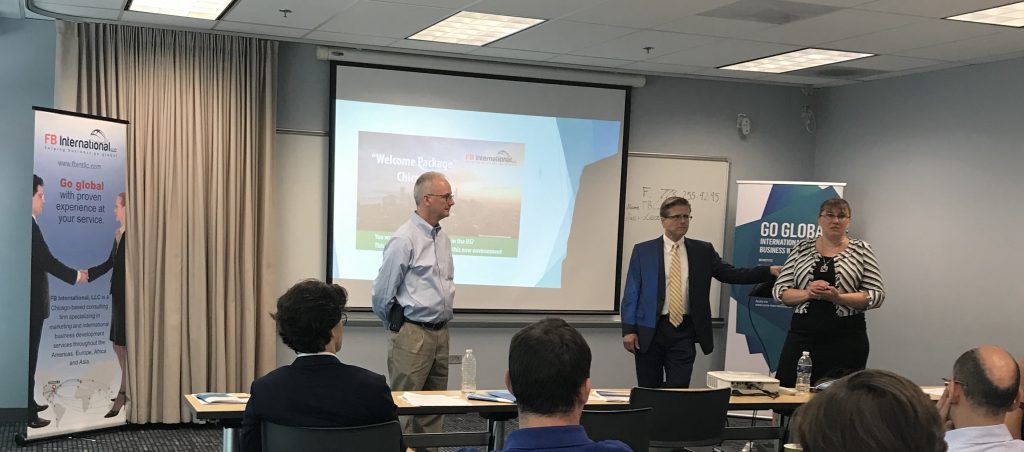
From left to right: Fabrice Bonvoisin, President of FB International LL; Thomas Beube, SVP and Director of International Services at Wintrust Financial Corporations; Jennifer Watson, Principal Attorney at Masuda Funai
The day closed with five riveting presentations from big-name speakers representing different industries in Chicago. Howard A. Tullman, former CEO of 1871, the non-profit startup hub, and Executive Director of the Ed Kaplan Family Institute for Innovation and Tech Entrepreneurship at IIT, spoke about his work and discusses his vision for innovation, entrepreneurship, and their constant evolution. Ted Souder, Head of Industry and Retail Group at Google regaled the audience with his personal story of coming to Chicago—one that involves risk-taking and pioneering within the international giant we all know today. Mark Harris, President and CEO of the Illinois Science & Technology Coalition, Todd Beauchamp, Chairman of the Technology & Manufacturing Association (TMA), and Brent Case, Senior Vice President, Business Development from Intersect Illinois all helped demonstrate to the delegates that Chicago is one of the best places in the U.S. to do business.
The European visitors and some speakers were able to unwind with a cocktail party in Catherine Vorwald’s office which, from the 10th floor of the office-only incubator tower, has an amazing view of the Chicago skyline and Lake Michigan.
Tuesday, June 19th was the first day of business-to-business meetings around Chicagoland for the ten European companies. FB International LLC, as the partner of RYME+, had been working since January to identify the needs of the delegates and to organize more than sixty B2B meetings for potential collaborations.
Tuesday afternoon the delegation traveled to Aurora, Illinois—the state’s second city—for a networking event organized by FB International LLC, Judy Dawson of Invest Aurora, Kathy Gilmore of the Valley Industrial Association (VIA), Mark VanKerkhoff of Kane County, and Mayor Irvin, Deputy Mayor Nelson, and CIO Michael Pegues of the City of Aurora. This event was an animated and dynamic exchange between the RYME+ companies and representatives from different sectors around Aurora and the surrounding counties. It was a great opportunity for the delegates to see that the American (and Illinoisan) market is truly a mosaic, made up of opportunities both in big cities and in smaller ones with strong manufacturing roots with an eye towards the future. We ended the evening with dinner and drinks at The Dock at Montrose Beach.
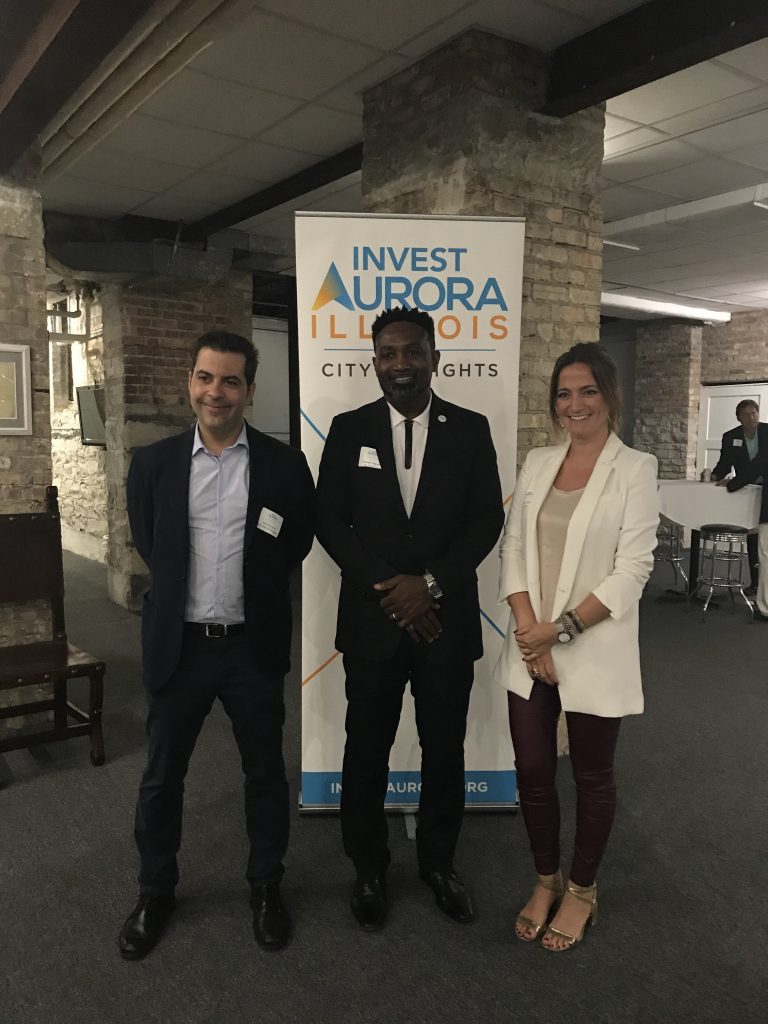
From left to right: Javier Pita, CEO of Navliens; Michael Pegues, CIO City of Aurora; Esther Peñalver Ibarra of the Murcia European Innovation Business Center
After a full week of meetings, punctuated by high-profile presentations and lively networking events, we are happy to say that the RYME+ trade mission to Chicagoland has been a great success. The participating companies are now busy following up with leads to best explore what the American market has to offer them. To find out more about the work FB International LLC did with the RYME+ delegation or the companies involved, click here.
Should you want to be available for the next trade mission, please subscribe to the FB International newsletter by clicking here.
Learn more about how we can make your
market development a success, in the U.S. or in another country.